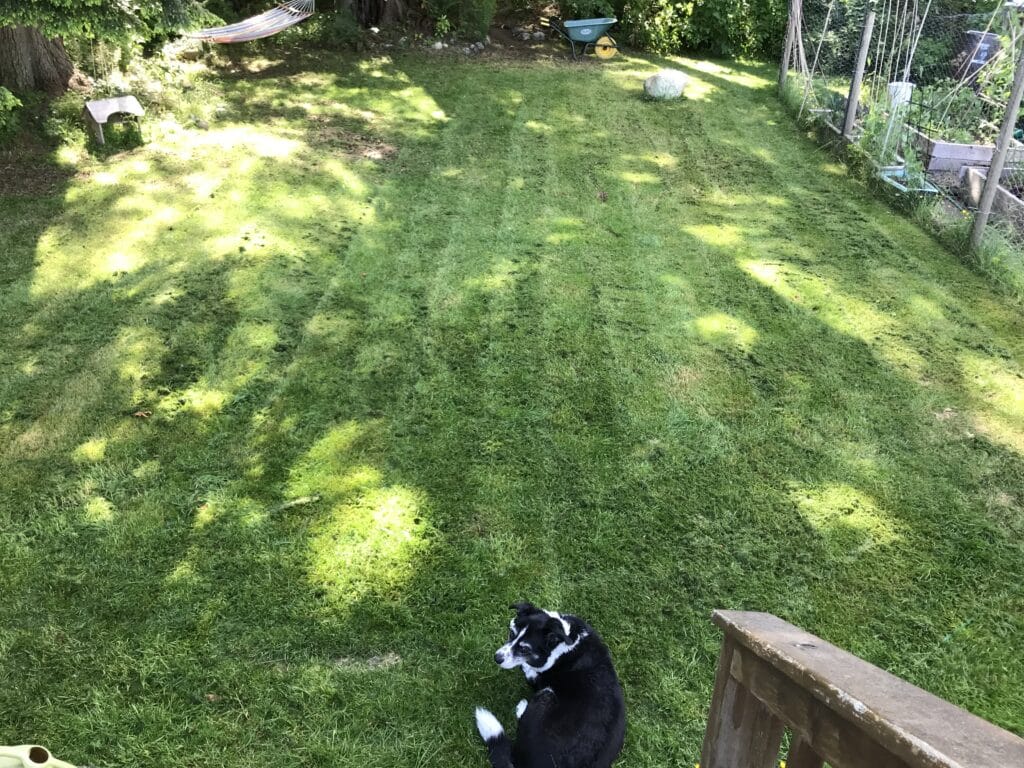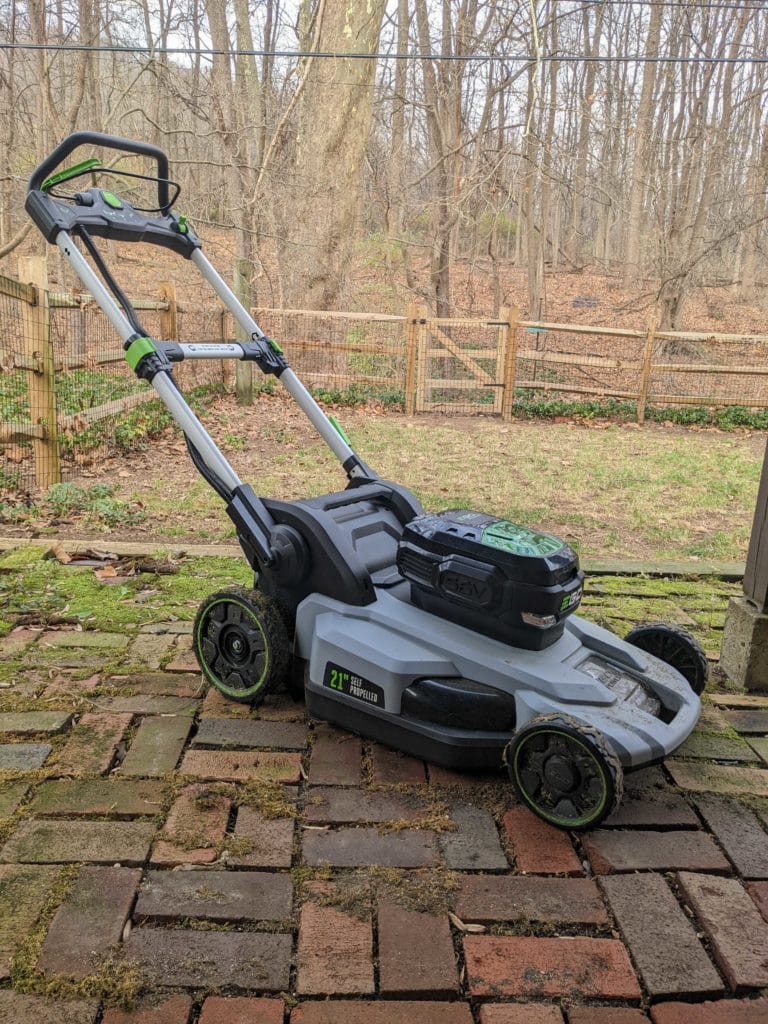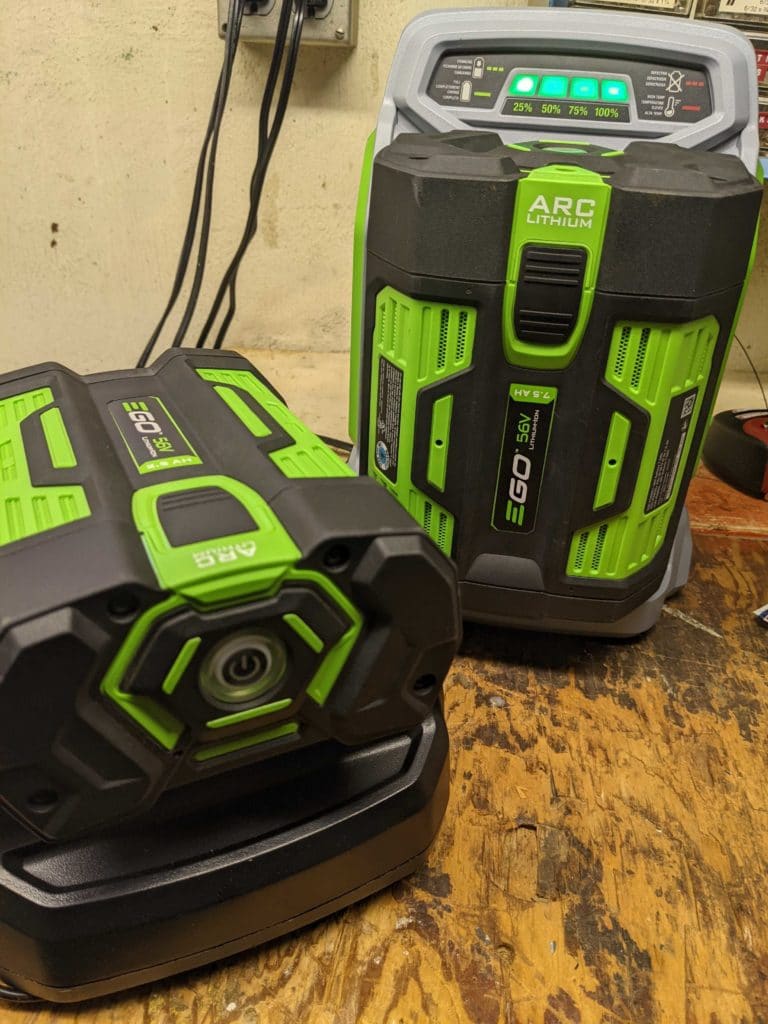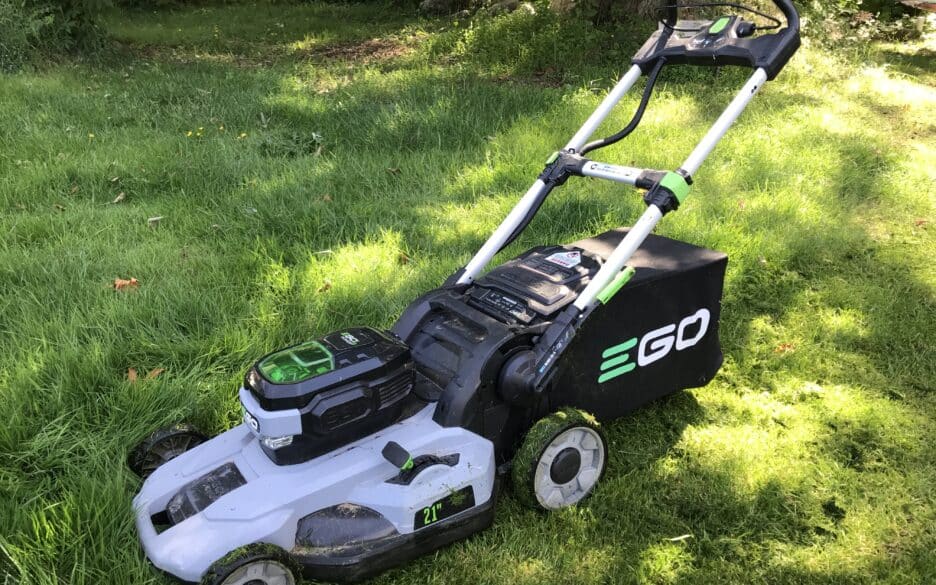We tested some of the best tailpipe emission-free, electric lawn mowers around. Here are our top choices, based on personal experience.

Think your choice of lawn mower doesn’t matter?
Mowing the average lawn in the U.S. creates as much air pollution as driving the family car on a 200-mile trip.
To help more folks make the switch to a greener way to keep your green green, we rated, and tested, emission free lawn mowers and listed our top picks below.
If you’re still undecided about gas vs. electric, we break it all down here. And if you want more info on the environmental impact of lawn mowing, I nerd out about that too.
Beware second-hand electric mowers with older batteries; the mower itself may be sold cheap compared to a new model, but the included battery or batteries may be next to useless and cost more than the mower to replace.
Curious about how we rate products? Click here to view our methodology, which at its core, is about voting with our dollars to fight climate change.
Our top picks
- Same torque as a gas powered mower
- Multiblade SelectCut system
- Huge collector bag – but doesn’t lose traction even when full!
- Very quiet
- Easy to store – folds upright
- Can mow the lawn at night
- Weather-resistant construction
- 75 min cut time
- 60 min charge time
- Higher priced than competitors
- Batteries are expensive, with a 3-5 year lifespan
- Huge collector bag, when full, makes the machine heavy to operate
The EGO 2156SP is our top pick for an electric mower. The earlier iteration of this model, the self-propelled LM2102SP has been thoroughly tested by the Leaf Score team, and the updated version comes with the multiblade SelectCut system and even greater run-time!
This model is a 21 in. 56-Volt Lithium-ion Cordless Walk Behind Self Propelled Mower that now comes with a 10 Ah battery and rapid charger. The self-propelled 21-inch 56V Ego has earned more than 6,000 5-star reviews at Home Depot online and a reputation elsewhere for high performance and usability.
Overall, this EGO model is our top pick for an electric lawn mower that can easily handle larger lawns.
This mower delivers the same high torque as gas-powered mowers without the air pollution and noise, and at a lower price! If your lawn area is half an acre or more, this monster of a mower might be your new best friend. It even boasts headlights, so you can do a spot of evening mowing should you wish.
Our experience
Saves space. One of our favorite features of the LM21 SP model is its ability to neatly fold up with a few quick releases of a lever or two. If you’re short on storage space for yard tools, this space-saving feature is very welcome.
Mow at night. Our Leaf Score tester was surprised to find he loved the LED lights on the Ego. In Pennsylvania fall, there isn’t much time between the end of the workday and it being too dark to mow. With half of the front yard left to mow while the sun was quickly setting, the headlights on the mower made it a total non-issue.



One big plus for the EGO is that huge collector bag. This means you can mow a large area of lawn without having to stop to empty the bag. The downside being that the machine becomes quite heavy by the end of your run and you’re using battery power to haul around grass clippings, perhaps unnecessarily.
Happily, this model doesn’t seem to lose traction at the front when the bag is nearing capacity, unlike some other models. Still, it’s best to empty out that bag to improve efficiency, or just use the mulching option to keep your lawn green.
- More torque than a similar size gas powered mower
- 21-inch deck size
- 6 cutting heights – 1.5-4 inches
- Easy to adjust deck height with a single lever
- 3-in-1 mulching, bagging, side discharge options
- Huge collector bag – but doesn’t lose traction even when full!
- Very quiet while mowing
- Easy to store – folds upright, with folding handle
- Can mow the lawn at night!
- 45 min cut time (I get almost 60 mins!) with 5 Ah battery
- 50 min charge time
- Cheaper options are available
- Huge collector bag, when full, makes the machine heavy to operate
- Battery lifespan is just 3-5 years
- Replacement EGO batteries are very expensive
- EGO manual and online info isn’t helpful for decoding all the flashing lights and indicators
- Not self-propelled, so you do have to put a little labor into mowing
After researching the topic of electric lawn mowers four years ago, I had no doubt that the EGO LM2100 was the one for me. Four years on and I still love it. I dig into why, and what could be better, in my full review.



- It handles like a dream – the robust but lightweight build means you can move this beast with just one hand! If you’re used to a self-propelled mower, this could be the machine to help you switch to more active mowing.
- It’s light and compact enough to carry up and down stairs and store in small spaces.
- It’s quiet, with little vibration at the handle, and smog-free – I can even mow while my baby is sleeping!
I got my EGO LM2100 with the recommended 56V 5.0 Ah ARC Lithium™ battery, which was a good chunk of money upfront but worth it for easy, smog-free, quiet lawn maintenance. Newer models tend to come with bigger batteries, up to 10 Ah, for even longer run-times. All EGO batteries are compatible with all EGO tools though.
Because I love my EGO mower and weed whacker, I’m looking into more affordable third-party replacement batteries. After all, it’s not super sustainable or budget-friendly to have to replace batteries every few years or ditch a machine entirely because battery costs are too high.
Despite this big downside, the EGO LM2100 is still my top choice for a walk-behind, not-self-propelled electric mower as it just knocks the competition out of the water. My advice though is to treat the battery with great care, even if you’re less cautious with the mower itself. If the battery shows any signs of failing before the 3 year mark, contact EGO before the warranty expires.
- A little cheaper than the Ego
- 21-inch deck
- Equivalent power to a 160 cc gas mower
- 60 min run time for two batteries
- 60 min charge time for two batteries
- Batteries work with other Greenworks tools
- Clear diagnostic LED battery charge indicator
- Low suction compared to other brands
- Foam handle jiggles a bit and could be more robust
- Too large for very small lawns – big wheels and wide deck
The Greenworks PRO 21-Inch 80V Cordless Lawn Mower GLM801602 is a top pick for those looking to be convinced of the merits of electric mowers versus gas mowers. Both Greenworks 80 V models mean business and costs around $500-$600 for the PRO 21-Inch 80 V with a 4.0 Ah battery and charger.
Because this model comes with two batteries, you can have one charging while the other is in use.
Greenworks also makes the Self-Propelled 80 V 21 Inch Cordless Lawn Mower (without batteries or charger) (View Price on Amazon) with all the same great features plus self-propulsion courtesy of the back wheels. This model is compatible with the 2 Ah and 4 Ah batteries.
The variable speed control (on the handle) has options for 0.5-1.5 m/s. The self-propelled model is a great choice if:
- You struggle to push a mower around, especially when heavy with grass clippings
- You have hillier terrain.
You can also get the self-propelled model with a 5 Ah battery and rapid charger (View Price on Amazon). This provides 70 minutes of run time and charges fully in just 75 minutes. Compared to the almost four hours needed to charge a single 2.5 Ah Black & Decker battery, this charger and battery combo is much more efficient and user friendly.
The minimum cutting height on this model is a little higher than on some other mowers, but there are seven possible settings, easily toggled using the large lever on the handle. This means it’s likely you’ll find a setting to suit your grass:
One small issue with the Greenworks Pro is the relatively low suction compared to the Snapper XD. This can mean that grass clippings don’t always get sucked into the collector on the first pass, necessitating a bit of back and forth. With the Snapper, the greater suction means you rarely need a second pass.
The Greenworks rapid charger was Energy Star rated (the program’s discontinued), has a compact design, and can be stored on a shelf or mounted on the wall. It is compatible with battery models GBA80200 and GBA400, but, and this is a big annoyance across the industry, this charger only works with Greenworks PRO 80 V batteries. It won’t work with other brands’ 80 V batteries. The same is true of the Ego Power batteries, though, so this isn’t an annoyance unique to Greenworks.
If you buy a Greenworks PRO lawn mower or other tool without the battery and charger, you can purchase their PRO 80V Lithium Ion Single Port Rapid Battery Charger GCH8040 for less than $100. This charger has a built-in fan to enable rapid charge time without overheating.
- More affordable than competitors
- Self-propelled with comfortable, ergonomic rubber handle
- 21-inch rust-resistant 14 gauge steel deck
- 45-min run time / 60-min with both 2 Ah batteries
- 7 height settings from 1.4-3.7 inches.
- Single lever adjustment
- Easy push-button start
- Load sensing technology
- Brushless motor
- Compatible with Briggs & Stratton 82 V Max 2 Ah and 4 Ah batteries
- StepSense Automatic Drive System – to match your pace
- Quiet, powerful, and compact
- 3-in-1 mulch, bag, side-discharge options
- 1.7 bushel bagger (60 L) collector bag
- Made in the US
- Can’t disengage blades to safely move mower using self-propulsion
- No environmental initiatives at the company
- Shorter run time than competitors
The Snapper XD 82 V MAX lawn mower is a self-propelled model ideal for larger lawns (View Price on Amazon). If you have half an acre to an acre to mow, this powerful electric mower is just the ticket. It includes two 2 Ah batteries to provide up to 60 minutes of run time.
You might also want to check out the Snapper SX 21SPWM 82 V model (View Price on Amazon). This model has a slightly smaller collector bag (1.6 bushels) and doesn’t feature the StepSense system. Run time for this model is 45 minutes, with batteries charging in a half hour.
One downside to both of these models is that you can’t disengage the mower’s blades and use the self-propulsion function to easily move the mower across areas that might damage the blades. As such, the Ego is a better bet if this is something you’ll find useful.
Snapper is part of the Briggs & Stratton corporation, with headquarters in Milwaukee, Wisconsin. The company provides more than 3,000 American jobs, but there’s no mention of CSR or sustainability programs on their website or elsewhere. I’ve reached out to the company for comment and will provide updates if/when I hear back from Snapper.
- Often on sale for under $200!
- Small 14-inch cutting deck for high maneuverability
- Steel cutting deck
- 4 Ah battery and 25-min run time
- 10.6 gallon collector bag or rear chute
- Batteries and charger work with a wide range of Sun Joe tools
- Removable safety key to prevent accidental starts
- Handle folds down
- Short run time
- 28 V lower power mower
- Not self-propelling
- Only 3 cutting heights
- Easy to lose the safety key! Get a spare just in case
- Doesn’t fold flat
The very inexpensive Sun Joe MJ401C Pro Cordless Lawn Mower is a great option for small lawns. This one has a smaller steel cutting deck of just 14 inches, and just three cutting heights.
Sun Joe mower batteries and charger work with the company’s entire outdoor power tool range, including:
- Trimmers
- Tillers
- Snow blowers
- Etc.
As a parent to a lawn-mower-loving toddler, I like that this model has a removable safety key to help prevent accidental starts. However, I would strong suggest getting a spare key… for when this one inevitably gets lost in the shed.
Note too that the Sun Joe doesn’t fold flat. The top part of the handle does fold down, but the overall height will still be two and a half feet.
- No need to charge batteries or top up gas
- 19-inch cutting deck (20-inch overall width)
- Often on sale for under $250!
- Highly maneuverable, thanks to 10-inch rear wheels
- Mulching, side discharge and bagging functions
- Weighs just 53 pounds
- Convenient carry handles!
- 3 handle height settings
- 7 cutting height settings, from 1.5 inches to 4 inches
- Single lever adjustments (on the top of the housing)
- 4-year guarantee
- Have to work around the cord
- Not self-propelled
Finally, the Black & Decker MM2000 is easily my top pick for a corded mower. This affordable option is great if you don’t mind managing an electric cord and have a small yard or lawn.
The MM2000 is very well equipped to tackle whatever you throw at it, assuming that something is within reach of an electrical outlet.
It can handle:
- Thick grass
- Wet grass (though you should really mow when it’s dry!)
- Long grass
- The occasional foreign object.
This is thanks to its durable 20-inch (19-inch blade) steel deck and 13 Amps, which runs off a 120 V outlet. The mower is set to mulching mode, so if you’d rather use the collector you’ll need to first remove the mulching ‘plug’ and attach the bag, all of which is very straightforward.
This lightweight mower is super easy to push around garden beds and over uneven terrain. The cord on this mower extends 150 feet, and you can get Black & Decker extension cords for up to another 100 feet of range.
The Black & Decker outperforms similarly priced mowers such as those from Ryobi, making it the best corded mower around and one of the greenest choices for a lawn mower.
If you have need of an even narrower lawn mower, Black & Decker also makes a very similar model to this one but with a 17-inch deck.
What about batteries?
Most battery-powered lawn mowers are powered by lithium-ion batteries, which are just bigger versions of the lithium batteries in our laptops and cellphones. You can store a lot of energy in a lithium battery compared to older types of batteries, which is why electric lawn mowers are now possible and, indeed, comparable in power to a gas-powered lawnmower.
Unfortunately, lithium batteries are expensive and deteriorate over several years, with their capacity decreasing as the cells in the battery die off. It’s a good idea, therefore, to have a spare battery and to replace the battery every few years to ensure good performance.
Final thoughts
Four years on and I still love my Ego mower. If you’ve made the switch too, or are thinking about it, let me know in the comments. After a slew of storms and major (fence crushing) trees falling in my yard, I’ve also been enjoying some quality time with my favorite electric chainsaws too.
Finally, if it snows where you live, check out our top picks for the best electric snowblowers.






Hi-
I’m just getting started with looking for a dependable cordless e-mower. I live in Oklahoma, where I have both fescue and Bermuda grass. Bermuda grass is a thick, hardy grass, so I need to make sure that the mower I purchase can cut through it. Fescue is softer, so I foresee no problem there.
Lawn size: Right now I mow the back yard (4000 sq. ft.) and have the front done by a service (4000 sq. ft. also). Is 4000 sq ft. a small yard or a medium or large yard? It takes me 30-45 min. to do the backyard.
I’m also concerned about finding someone who repairs e-movers. I have a guy who services gas-powered mowers but not electric ones. Hopefully, these mowers are dependable enough that one only needs to sharpen the blade to keep it in shape.
Thanks for any help you can give.
Richard Henry
Norman OK
Hi Richard,
Thanks for reaching out.
The Greenworks mowers have a solid reputation for being able to handle Bermuda grass, and the Black & Decker MM2000 is also good for denser grass like Bermuda. The only thing to note is that you’re more likely to have to empty out the collectors and maybe scale down expectations of battery runtime if cutting especially dense lawn. As in, if battery run time is 60 mins, it might be 45 or less for Bermuda-heavy lawns as the mower is working harder.
Regarding servicing, the electric yard appliance servicing industry is booming, so it would surprise me if there wasn’t somebody in Norman or nearby who could take a look at your machine now and then. And if you buy a well-regarded brand, you’ll also have their customer service on hand and likely be able to send the machine in for repair should that be necessary. They’re pretty robust though!
Hope that helps,
Leigh
Hello, read your review, went to purchase on Amazon. Where do I order the extra 100 ft cord for $19.00. I saw items purchased with mower…100 ft cord 3 prong…but shows $39.00.
Thank you for your time and consideration of a reply.
Hi Peggy,
Looks like the price for the cord has gone up substantially since this piece went to press. I’ve changed the post accordingly. In the meantime, it seems like the 50 ft. cord is still $18.99, so this may be better value unless you absolutely need the 100 ft. extension.
Thanks for letting us know – prices are always changing!
Leigh
Hi-
I read your article because I am looking to replace my existing battery-operated EGO mower. I share the same concern with the first gentleman about finding someone to work on it. I love my EGO mower (I also own their blower and weed-eater), but have had an issues with the wiring/starter of the mower lately because of how the handle folds in for storage. EGO has told me that the mower is not under warranty (5 years) because the mower was built in 2015 even though I purchased it in 2017. The repair person told me he didn’t have much experience with electric mowers and recommended a gas model. I have not had much luck with EGO’s customer service with being helpful. Just thought I would put that out there that sometimes reviewing mowers isn’t enough. Finding places to service and dealing with customer service are just as important. Thank you for the comprehensive article. Very informative.
Hi Holly,
That’s good to know! Here’s hoping there’ll be more people trained to use these battery-powered tools in the next few years as more folks make the switch away from gas. I had heard good things about Ego’s customer service, so I’m sorry to hear you didn’t have a great experience. Did you get the wiring issue sorted eventually?
Leigh